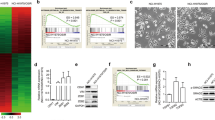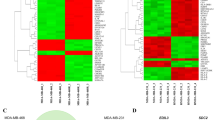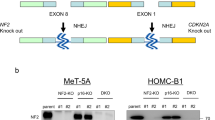Abstract
Malignant mesothelioma (MM) is an aggressive tumor commonly caused by asbestos exposure after a long latency. Focal adhesion kinase (FAK) inhibitors inhibit the cell growth of Merlin-deficient MM cells; however, their clinical efficacy has not been clearly determined. The aim of this study was to evaluate the growth inhibitory effect of the FAK inhibitor VS-4718 on MM cell lines and identify biomarkers for its efficacy. Although most Merlin-deficient cell lines were sensitive to VS-4718 compared with control MeT-5A cells, a subset of these cell lines exhibited resistance to this drug. Microarray and qRT–PCR analyses using RNA isolated from Merlin-deficient MM cell lines revealed a significant correlation between E-cadherin mRNA levels and VS-4718 resistance. Merlin- and E-cadherin-negative Y-MESO-22 cells underwent apoptosis upon treatment with a low concentration of VS-4718, whereas Merlin-negative, E-cadherin-positive Y-MESO-9 cells did not undergo VS-4718-induced apoptosis. Furthermore, E-cadherin knockdown in Merlin-negative MM cells significantly sensitized cells to VS-4718 and induced apoptotic cell death upon VS-4718 treatment. Together, our results suggest that E-cadherin serves as a predictive biomarker for molecular target therapy with FAK inhibitors for patients with mesothelioma and that its expression endows MM cells with resistance to FAK inhibitors.
This is a preview of subscription content, access via your institution
Access options
Subscribe to this journal
Receive 50 print issues and online access
$259.00 per year
only $5.18 per issue
Buy this article
- Purchase on Springer Link
- Instant access to full article PDF
Prices may be subject to local taxes which are calculated during checkout





Similar content being viewed by others
Accession codes
References
Robinson BW, Musk AW, Lake RA . Malignant mesothelioma. Lancet 2005; 366: 397–408.
Robinson BW, Lake RA . Advances in malignant mesothelioma. N Engl J Med 2005; 353: 1591–1603.
Frank AL, Joshi TK . The global spread of asbestos. Ann Glob Health 2014; 80: 257–262.
Japan Ministry of Health, Labour and Welfare. Trends in deaths due to malignant mesothelioma from vital statistics of Japan 1995-2014 [Internet]. 2015 [cited 24 Oct. 2016]. Available from: http://www.mhlw.go.jp/toukei/saikin/hw/jinkou/tokusyu/chuuhisyu14/index.html.
Sekido Y . Genomic abnormalities and signal transduction dysregulation in malignant mesothelioma cells. Cancer Sci 2010; 101: 1–6.
Vogelzang NJ, Rusthoven JJ, Symanowski J, Denham C, Kaukel E, Ruffie P et al. Phase III study of pemetrexed in combination with cisplatin versus cisplatin alone in patients with malignant pleural mesothelioma. J Clin Oncol 2003; 21: 2636–2644.
Bianchi AB, Mitsunaga SI, Cheng JQ, Klein WM, Jhanwar SC, Seizinger B et al. High frequency of inactivating mutations in the neurofibromatosis type 2 gene (NF2) in primary malignant mesotheliomas. Proc Natl Acad Sci USA 1995; 92: 10854–10858.
Sekido Y, Pass HI, Bader S, Mew DJ, Christman MF, Gazdar AF et al. Neurofibromatosis type 2 (NF2) gene is somatically mutated in mesothelioma but not in lung cancer. Cancer Res 1995; 55: 1227–1231.
Guo G, Chmielecki J, Goparaju C, Heguy A, Dolgalev I, Carbone M et al. Whole-exome sequencing reveals frequent genetic alterations in BAP1, NF2, CDKN2A, and CUL1 in malignant pleural mesothelioma. Cancer Res 2015; 75: 264–269.
Bueno R, Stawiski EW, Goldstein LD, Durinck S, De Rienzo A, Modrusan Z et al. Comprehensive genomic analysis of malignant pleural mesothelioma identifies recurrent mutations, gene fusions and splicing alterations. Nat Genet 2016; 48: 407–416.
Altomare DA, Vaslet CA, Skele KL, De Rienzo A, Devarajan K, Jhanwar SC et al. A mouse model recapitulating molecular features of human mesothelioma. Cancer Res 2005; 65: 8090–8095.
Xiao GH, Gallagher R, Shetler J, Skele K, Altomare DA, Pestell RG et al. The NF2 tumor suppressor gene product, merlin, inhibits cell proliferation and cell cycle progression by repressing cyclin D1 expression. Mol Cell Biol 2005; 25: 2384–2394.
Poulikakos PI, Xiao GH, Gallagher R, Jablonski S, Jhanwar SC, Testa JR . Re-expression of the tumor suppressor NF2/merlin inhibits invasiveness in mesothelioma cells and negatively regulates FAK. Oncogene 2006; 25: 5960–5968.
Murakami H, Mizuno T, Taniguchi T, Fujii M, Ishiguro F, Fukui T et al. LATS2 is a tumor suppressor gene of malignant mesothelioma. Cancer Res 2011; 71: 873–883.
Tanaka I, Osada H, Fujii M, Fukatsu A, Hida T, Horio Y et al. LIM-domain protein AJUBA suppresses malignant mesothelioma cell proliferation via Hippo signaling cascade. Oncogene 2015; 34: 73–83.
Mizuno T, Murakami H, Fujii M, Ishiguro F, Tanaka I, Kondo Y et al. YAP induces malignant mesothelioma cell proliferation by upregulating transcription of cell cycle-promoting genes. Oncogene 2012; 31: 5117–5122.
Kakiuchi T, Takahara T, Kasugai Y, Arita K, Yoshida N, Karube K et al. Modeling mesothelioma utilizing human mesothelial cells reveals involvement of phospholipase-C beta 4 in YAP-active mesothelioma cell proliferation. Carcinogenesis 2016; 37: 1098–1109.
Cole BK, Curto M, Chan AW, McClatchey AI . Localization to the cortical cytoskeleton is necessary for Nf2/merlin-dependent epidermal growth factor receptor silencing. Mol Cell Biol 2008; 28: 1274–1284.
Stamenkovic I, Yu Q . Merlin, a ‘magic’ linker between extracellular cues and intracellular signaling pathways that regulate cell motility, proliferation, and survival. Curr Protein Pept Sci 2010; 11: 471–484.
Lopez-Lago MA, Okada T, Murillo MM, Socci N, Giancotti FG . Loss of the tumor suppressor gene NF2, encoding merlin, constitutively activates integrin-dependent mTORC1 signaling. Mol Cell Biol 2009; 29: 4235–4249.
James MF, Han S, Polizzano C, Plotkin SR, Manning BD, Stemmer-Rachamimov AO et al. NF2/merlin is a novel negative regulator of mTOR complex 1, and activation of mTORC1 is associated with meningioma and schwannoma growth. Mol Cell Biol 2009; 29: 4250–4261.
Li W, Cooper J, Karajannis MA, Giancotti FG . Merlin: a tumour suppressor with functions at the cell cortex and in the nucleus. EMBO Rep 2012; 13: 204–215.
Mitra SK, Hanson DA, Schlaepfer DD . Focal adhesion kinase: in command and control of cell motility. Nat Rev Mol Cell Biol 2005; 6: 56–68.
Gabarra-Niecko V, Schaller MD, Dunty JM . FAK regulates biological processes important for the pathogenesis of cancer. Cancer Metastasis Rev 2003; 22: 359–374.
Shapiro IM, Kolev VN, Vidal CM, Kadariya Y, Ring JE, Wright Q et al. Merlin deficiency predicts FAK inhibitor sensitivity: a synthetic lethal relationship. Sci Transl Med 2014; 6: 237ra268.
Usami N, Fukui T, Kondo M, Taniguchi T, Yokoyama T, Mori S et al. Establishment and characterization of four malignant pleural mesothelioma cell lines from Japanese patients. Cancer Sci 2006; 97: 387–394.
Taniguchi T, Karnan S, Fukui T, Yokoyama T, Tagawa H, Yokoi K et al. Genomic profiling of malignant pleural mesothelioma with array-based comparative genomic hybridization shows frequent non-random chromosomal alteration regions including JUN amplification on 1p32. Cancer Sci 2007; 98: 438–446.
Houshmandi SS, Emnett RJ, Giovannini M, Gutmann DH . The neurofibromatosis 2 protein, merlin, regulates glial cell growth in an ErbB2- and Src-dependent manner. Mol Cell Biol 2009; 29: 1472–1486.
Tanjoni I, Walsh C, Uryu S, Tomar A, Nam JO, Mielgo A et al. PND-1186 FAK inhibitor selectively promotes tumor cell apoptosis in three-dimensional environments. Cancer Biol Ther 2010; 9: 764–777.
Kenny PA, Lee GY, Myers CA, Neve RM, Semeiks JR, Spellman PT et al. The morphologies of breast cancer cell lines in three-dimensional assays correlate with their profiles of gene expression. Mol Oncol 2007; 1: 84–96.
Shah NR, Tancioni I, Ward KK, Lawson C, Chen XL, Jean C et al. Analyses of merlin/NF2 connection to FAK inhibitor responsiveness in serous ovarian cancer. Gynecol Oncol 2014; 134: 104–111.
Lallemand D, Saint-Amaux AL, Giovannini M . Tumor-suppression functions of merlin are independent of its role as an organizer of the actin cytoskeleton in Schwann cells. J Cell Sci 2009; 122: 4141–4149.
Ishiguro F, Murakami H, Mizuno T, Fujii M, Kondo Y, Usami N et al. Activated leukocyte cell-adhesion molecule (ALCAM) promotes malignant phenotypes of malignant mesothelioma. J Thorac Oncol 2012; 7: 890–899.
Mani SA, Guo W, Liao MJ, Eaton EN, Ayyanan A, Zhou AY et al. The epithelial-mesenchymal transition generates cells with properties of stem cells. Cell 2008; 133: 704–715.
Luo M, Fan H, Nagy T, Wei H, Wang C, Liu S et al. Mammary epithelial-specific ablation of the focal adhesion kinase suppresses mammary tumorigenesis by affecting mammary cancer stem/progenitor cells. Cancer Res 2009; 69: 466–474.
Lim ST . Nuclear FAK: a new mode of gene regulation from cellular adhesions. Mol Cells 2013; 36: 1–6.
Dong LL, Liu L, Ma CH, Li JS, Du C, Xu S et al. E-cadherin promotes proliferation of human ovarian cancer cells in vitro via activating MEK/ERK pathway. Acta Pharmacol Sin 2012; 33: 817–822.
McLean GW, Carragher NO, Avizienyte E, Evans J, Brunton VG, Frame MC . The role of focal-adhesion kinase in cancer—a new therapeutic opportunity. Nat Rev Cancer 2005; 5: 505–515.
Sieg DJ, Hauck CR, Ilic D, Klingbeil CK, Schaefer E, Damsky CH et al. FAK integrates growth-factor and integrin signals to promote cell migration. Nat Cell Biol 2000; 2: 249–256.
Jiang H, Hegde S, Knolhoff BL, Zhu Y, Herndon JM, Meyer MA et al. Targeting focal adhesion kinase renders pancreatic cancers responsive to checkpoint immunotherapy. Nat Med 2016; 22: 851–860.
Xu LH, Yang X, Bradham CA, Brenner DA, Baldwin Jr AS, Craven RJ et al. The focal adhesion kinase suppresses transformation-associated, anchorage-independent apoptosis in human breast cancer cells. Involvement of death receptor-related signaling pathways. J Biol Chem 2000; 275: 30597–30604.
Nelson WJ . Regulation of cell–cell adhesion by the cadherin-catenin complex. Biochem Soc Trans 2008; 36: 149–155.
Gladden AB, Hebert AM, Schneeberger EE, McClatchey AI . The NF2 tumor suppressor, Merlin, regulates epidermal development through the establishment of a junctional polarity complex. Dev Cell 2010; 19: 727–739.
Canel M, Serrels A, Frame MC, Brunton VG . E-cadherin-integrin crosstalk in cancer invasion and metastasis. J Cell Sci 2013; 126: 393–401.
Sawada K, Mitra AK, Radjabi AR, Bhaskar V, Kistner EO, Tretiakova M et al. Loss of E-cadherin promotes ovarian cancer metastasis via alpha 5-integrin, which is a therapeutic target. Cancer Res 2008; 68: 2329–2339.
Zhang W, Alt-Holland A, Margulis A, Shamis Y, Fusenig NE, Rodeck U et al. E-cadherin loss promotes the initiation of squamous cell carcinoma invasion through modulation of integrin-mediated adhesion. J Cell Sci 2006; 119: 283–291.
Tang KJ, Constanzo JD, Venkateswaran N, Melegari M, Ilcheva M, Morales JC et al. Focal adhesion kinase regulates the DNA damage response and its inhibition radiosensitizes mutant KRAS lung cancer. Clin Cancer Res 2016; 22: 5851–5863.
Marlowe TA, Lenzo FL, Figel SA, Grapes AT, Cance WG . Oncogenic receptor tyrosine kinases directly phosphorylate focal adhesion kinase (FAK) as a resistance mechanism to FAK-kinase inhibitors. Mol Cancer Ther 2016; 15: 3028–3039.
Kawaguchi K, Murakami H, Taniguchi T, Fujii M, Kawata S, Fukui T et al. Combined inhibition of MET and EGFR suppresses proliferation of malignant mesothelioma cells. Carcinogenesis 2009; 30: 1097–1105.
Ordonez NG . The immunohistochemical diagnosis of mesothelioma: a comparative study of epithelioid mesothelioma and lung adenocarcinoma. Am J Surg Pathol 2003; 27: 1031–1051.
Addis B, Roche H . Problems in mesothelioma diagnosis. Histopathology 2009; 54: 55–68.
Muller AM, Weichert A, Muller KM . E-cadherin, E-selectin and vascular cell adhesion molecule: immunohistochemical markers for differentiation between mesothelioma and metastatic pulmonary adenocarcinoma? Virchows Arch 2002; 441: 41–46.
Saeed AI, Sharov V, White J, Li J, Liang W, Bhagabati N et al. TM4: a free, open-source system for microarray data management and analysis. Biotechniques 2003; 34: 374–378.
Breitling R, Armengaud P, Amtmann A, Herzyk P . Rank products: a simple, yet powerful, new method to detect differentially regulated genes in replicated microarray experiments. FEBS Lett 2004; 573: 83–92.
Kanda Y . Investigation of the freely available easy-to-use software 'EZR' for medical statistics. Bone Marrow Transplant 2013; 48: 452–458.
Acknowledgements
This work was supported by JSPS KAKENHI (Grant Numbers JP25290053 and JP16H04706), the Takeda Science Foundation, a Research Grant from the Princess Takamatsu Cancer Research Fund (14-24617), Project Mirai Cancer Research Grants, and P-DIRECT. We thank Dr Adi F Gazdar for the cell lines, Dr Hideki Murakami for his technical support during gene expression profiling, and Miwako Nishizawa for her excellent technical assistance. We gratefully thank Dr Hirotaka Osada for the study design and his careful supervision of the data (Dr Osada was a member of our lab and passed away on 23 August 2016).
Author information
Authors and Affiliations
Corresponding author
Ethics declarations
Competing interests
The authors declare no conflict of interest.
Additional information
Supplementary Information accompanies this paper on the Oncogene website
Rights and permissions
About this article
Cite this article
Kato, T., Sato, T., Yokoi, K. et al. E-cadherin expression is correlated with focal adhesion kinase inhibitor resistance in Merlin-negative malignant mesothelioma cells. Oncogene 36, 5522–5531 (2017). https://doi.org/10.1038/onc.2017.147
Received:
Revised:
Accepted:
Published:
Issue Date:
DOI: https://doi.org/10.1038/onc.2017.147
This article is cited by
-
Tumor-associated macrophage (TAM)-derived CCL22 induces FAK addiction in esophageal squamous cell carcinoma (ESCC)
Cellular & Molecular Immunology (2022)
-
Zoledronic acid-loaded lipidic nanoparticles enhance apoptosis and attenuate invasiveness by inhibiting epithelial to mesenchymal transition (EMT) in HepG2 cancer cells
Naunyn-Schmiedeberg's Archives of Pharmacology (2021)
-
The FAK inhibitor BI 853520 inhibits spheroid formation and orthotopic tumor growth in malignant pleural mesothelioma
Journal of Molecular Medicine (2019)
-
Efficacy of the highly selective focal adhesion kinase inhibitor BI 853520 in adenocarcinoma xenograft models is linked to a mesenchymal tumor phenotype
Oncogenesis (2018)
-
DNA methylation profiling of asbestos-treated MeT5A cell line reveals novel pathways implicated in asbestos response
Archives of Toxicology (2018)



